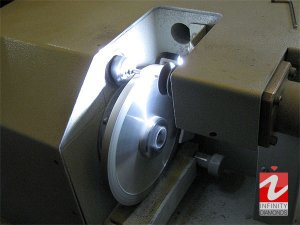helios_haze
Rough_Rock
- Joined
- May 8, 2008
- Messages
- 37
When you''re working with many substances, sure. But diamond is unlike any other substance, which is why it is so highly valued. As you might already know, diamond is not actually "cut" by anything other than another diamond: Rotary saws and wheels are coated with diamond dust to accomplish this...lasers can vaporize...but nothing but diamond can cut/polish another diamond.Date: 8/4/2008 11:57:36 PM
Author: helios_haze
Point taken!
But, don''t they use machines to cut these? Isn''t 1/25 th of a mm sizeable in this day and age of microns and nanotubes??

It''s not as simple as kicking a machine into action helios. I''ll try to explain before I mosey off to bed.Date: 8/5/2008 2:06:10 AM
Author: helios_haze
Thanks John ... great information!
But, I still do not have a clear answer to my question. Why is a RB not a geometric round/why is the cut radius uneven? I infer from John''s post that the hardness of diamond makes it very difficult to cut. However once the diamond-dusted saw MACHINES are rolling and cutting, why can''t they hold steady.
Don''t mean to be difficult - just curious











Indeed, absolutely fascinating, many thanks Sir John for sharing that with us!!Date: 8/5/2008 3:29:31 AM
Author: arjunajane
Awesome pics and info as always John, thanks for sharing!






My pleasure, m''ladies. I am in awe of the masters of these crafts; sorting, grading, planning, polishing...all of it.Date: 8/5/2008 3:31:46 AM
Author: Lorelei
Indeed, absolutely fascinating, many thanks Sir John for sharing that with us!!Date: 8/5/2008 3:29:31 AM
Author: arjunajane
Awesome pics and info as always John, thanks for sharing!




Most welcome Sir, it is wonderful for us to be able to see these pics and get a peek into the world where the magic happens!!Date: 8/5/2008 3:39:56 AM
Author: John Pollard
My pleasure, m'ladies. I am in awe of the masters of these crafts; sorting, grading, planning, polishing...all of it.Date: 8/5/2008 3:31:46 AM
Author: Lorelei
Indeed, absolutely fascinating, many thanks Sir John for sharing that with us!!Date: 8/5/2008 3:29:31 AM
Author: arjunajane
Awesome pics and info as always John, thanks for sharing!



And I appreciate you saying something.



Thanks Paul, this is all great info!Date: 8/5/2008 4:41:54 AM
Author: Paul-Antwerp
It may not have been clear in John''s posts, but the main reason for the stones not being perfectly round is that the growth of the diamond crystal (the grain) created four areas on the girdle with strong directional strength and four areas with weak directional strength.
Live long,
Date: 8/5/2008 3:31:51 AM
Author: John Pollard
And finally… This isn''t a usual specimen, but I thought it would be a nice finish to these pictures with a modest little 15-carat treat.
You can be sure a lot of planning and devotion went into this pretty little firecracker, but at the end of the day it isn''t perfectly round. However I''m betting the lady wearing it isn''t losing sleep over that fraction of a millimeter.



Definitely, FABULOUS thread!!!!Date: 8/5/2008 10:03:41 AM
Author: helios_haze
WOW!!! One for the ages!!!
Thanks John, Paul, and Gary. You guys rock (And I mean 15ct style)
Ditto. Great work John.Date: 8/5/2008 10:05:29 AM
Author: Lorelei
Definitely, FABULOUS thread!!!!Date: 8/5/2008 10:03:41 AM
Author: helios_haze
WOW!!! One for the ages!!!
Thanks John, Paul, and Gary. You guys rock (And I mean 15ct style)
Just FYI , a diamond isn''t the hardest substance in the universe anymore. Aggregated carbon nanorods have been synthesized that are harder and more dense than diamonds.Date: 8/5/2008 1:49:20 AM
Author: John Pollard
When you''re working with many substances, sure. But diamond is unlike any other substance, which is why it is so highly valued. As you might already know, diamond is not actually ''cut'' by anything other than another diamond: Rotary saws and wheels are coated with diamond dust to accomplish this...lasers can vaporize...but nothing but diamond can cut/polish another diamond.Date: 8/4/2008 11:57:36 PM
Author: helios_haze
Point taken!
But, don''t they use machines to cut these? Isn''t 1/25 th of a mm sizeable in this day and age of microns and nanotubes??
On the Moh''s hardness scale iron is 4 to 5. Quartz is 7 and even hardened steel is only 7 to 8. Diamond is the hardest substance in the known universe. at 10 on the Moh''s hardness scale it''s actually many times harder than corundum, which comes in at 9.
Click here for a visual representation: http://www.allaboutgemstones.com/images/mohs_hardness_scale.jpg